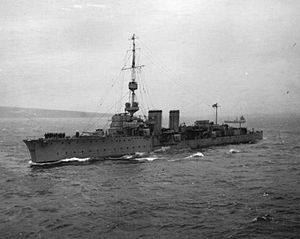HMS Castor (1915)

| |
| History | |
|---|---|
| Name | Castor |
| Builder | Cammell Laird |
| Laid down | 28 October 1914 |
| Launched | 28 July 1915 |
| Completed | November 1915 |
| Commissioned | November 1915 |
| Decommissioned | May 1935 |
| Fate | Sold 30 July 1936 for scrapping |
| General characteristics | |
| Class and type | C-class light cruiser |
| Displacement | 3,750 long tons (3,810 t) |
| Length | 446 ft (135.9 m) |
| Beam | 41.5 ft (12.6 m) |
| Draught | 15 ft (4.6 m) |
| Installed power |
|
| Propulsion | 4 propellers; 2 steam turbines |
| Speed | 28.5 knots (52.8 km/h; 32.8 mph) |
| Complement | 323 |
| Armament |
|
| Armour |
|
HMS Castor was one of the Cambrian subclass of the C class of light cruisers. She saw service during the First World War and the Russian Civil War.
Construction
Design of the Cambrian subclass was based on the earlier light cruisers
Castor was built by
Service history
World War I

Commissioned in November 1915, Castor was the flagship of Commodore (D), assigned to the 11th Destroyer Flotilla in the Grand Fleet. She fought in the Battle of Jutland, in which she was damaged by German gunfire and suffered 10 casualties.[1]
On 4 October 1917, the
Post-war
After the First World War, Castor served in the Black Sea from 1919 to 1920 during the British intervention in the Russian Civil War. In April 1920, she recommissioned at Chatham Dockyard for service in the 2nd Light Cruiser Squadron in the Atlantic Fleet.[1]
In 1921, Castor joined the light cruisers
Castor patrolled off the coast of Ireland in 1922 during the Irish Civil War. She was assigned to the Gunnery School at Portsmouth from 1923 to 1924, then was in the Nore Reserve from 1924 to 1925.[1]
Castor underwent a refit from November 1925 to September 1926, then began transporting troops to
Disposal
Castor was sold on 30 July 1936 for scrapping and arrived at the shipbreaker's yard at Rosyth in August 1936.
Notes
- ^ a b c d e Preston, p. 59
- ^ "Dictionary of American Naval Fighting Ships: Rehoboth I". Archived from the original on 2 November 2012. Retrieved 1 May 2014.
- ^ Naval History: HMS VANQUISHER, BALTIC CRUISE 1921
References
- ISBN 978-1-86176-281-8.
- ISBN 978-1-59114-078-8.
- ISBN 0-85177-245-5.
External links
- Cambrian Class Light Cruisers
- "Royal Navy Log Books of the World War 1 Era - HMS Castor". Retrieved 15 December 2013. Transcription of ship's logbooks November 1918 to May 1920
- Battle of Jutland Crew Lists Project - HMS Castor Crew List
